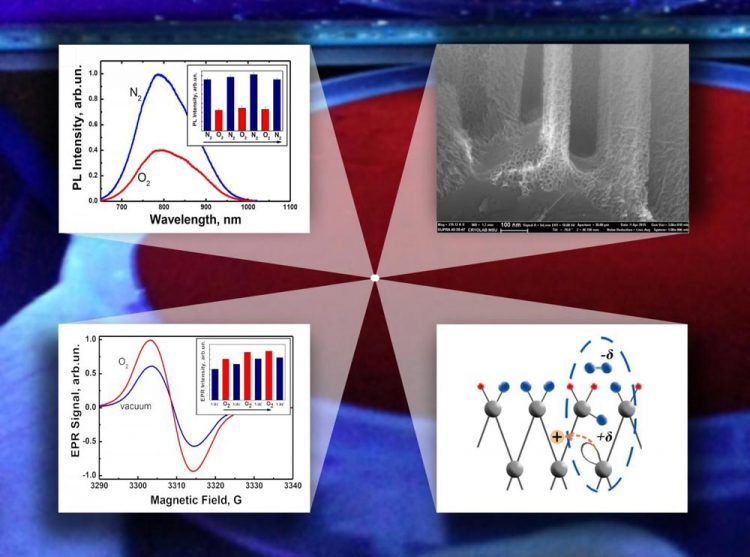The scientists from MSU developed a basis for highly sensitive gas sensors

Principle of the operation of the sensor based on porous silicon nanowire arrays. Credit: Liubov Osminkina
Taking into account high levels of environmental pollution in the modern world, it is important to develop new sensitive devices able to identify molecules in gas phase accurately and selectively. This is true both for toxic and non-toxic gases.
However, the majority of modern gas sensors only work at high temperatures which limits the scope of their application. Therefore the development of reusable highly sensitive gas detectors working at room temperatures is an important area of modern physics development.
The scientists from MSU suggested using porous silicon nanowire arrays as sensitive elements of such detectors. They can be obtained by means of a cheap method of the metal-assisted chemical etching. It is based on selective chemical etching, i.e. partial removal of surface layer from a bulk crystalline silicon with the use of metal nanoparticles as a catalyst. Moreover, the procedure is quite quick: at least 100 elements can be produced in a lab within just one hour.
Each sensor consists of an array of 10 micron long organized silicon nanowires with diameters ranging from 100 to 200 nm. Each nanowire has porous crystalline structure. The size of silicon crystals and pores between them in individual nanowire, varies from three to five nanometers.
Authors have shown that such porous nanowires have huge specific surface area due to which their physical and chemical properties are extremely sensitive to molecular environment. It was also found out that the obtained samples exhibited an effective photoluminescence in the red spectrum region at room temperature.
“For the first time we've shown that photoluminescence of silicon nanowires is quenched in oxygen (O2) atmosphere but then restored to initial values in the atmosphere of a noble gas – nitrogen (N2). This is repeated in several adsorption-desorption cycles,” said Liubov Osminkina, the head of the scientific group, PhD in physics and mathematics, and senior associate at the Faculty of Physics, MSU.
The scientists explained obtained experimental results with a microscopic model according to which the sensitivity of optical properties of the samples to their molecular environment is determined by reversible charging and discharging of Pb-centers – defects such as silicon dangling bonds on the surface of the nanowires. The authors of the study confirmed the model with measurements taken by using the electronic paramagnetic resonance method that helps determine existence and concentration of Pb-centers.
“What's important is that our sensors based on porous nanowires both work at home temperatures and also are reusable, because the all observed effects were completely reversible,” added Liubov Osminkina.
The new sensors may be used both for effective control of environment pollution levels and for the monitoring of air composition in closed spaces, from classrooms to space stations.
###
The work was supported with a grant of Russian Scientific Foundation.
Media Contact
All latest news from the category: Materials Sciences
Materials management deals with the research, development, manufacturing and processing of raw and industrial materials. Key aspects here are biological and medical issues, which play an increasingly important role in this field.
innovations-report offers in-depth articles related to the development and application of materials and the structure and properties of new materials.
Newest articles

A universal framework for spatial biology
SpatialData is a freely accessible tool to unify and integrate data from different omics technologies accounting for spatial information, which can provide holistic insights into health and disease. Biological processes…

How complex biological processes arise
A $20 million grant from the U.S. National Science Foundation (NSF) will support the establishment and operation of the National Synthesis Center for Emergence in the Molecular and Cellular Sciences (NCEMS) at…

Airborne single-photon lidar system achieves high-resolution 3D imaging
Compact, low-power system opens doors for photon-efficient drone and satellite-based environmental monitoring and mapping. Researchers have developed a compact and lightweight single-photon airborne lidar system that can acquire high-resolution 3D…





















